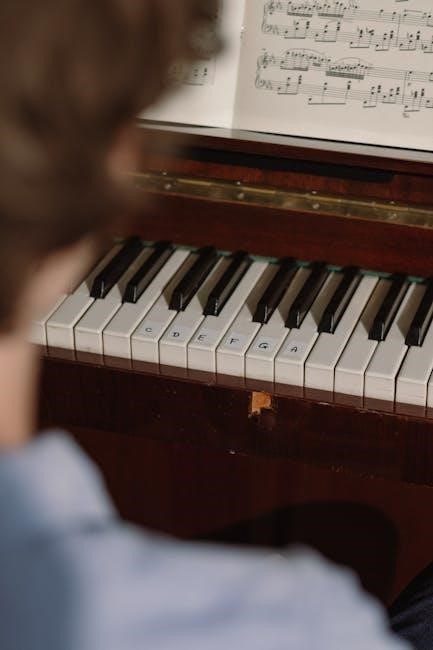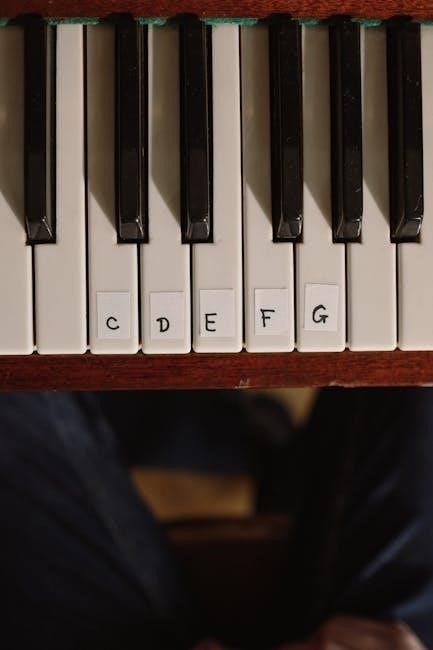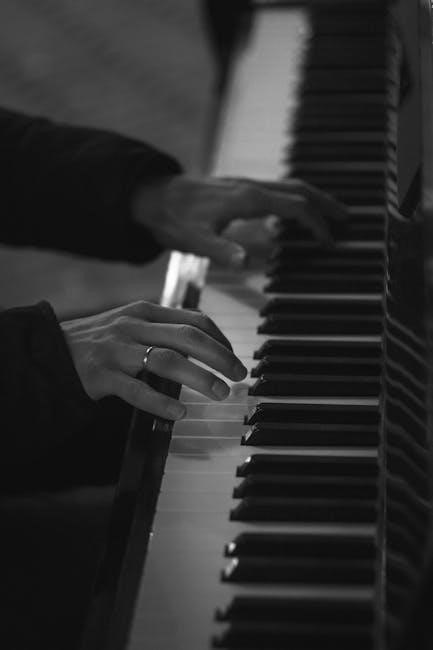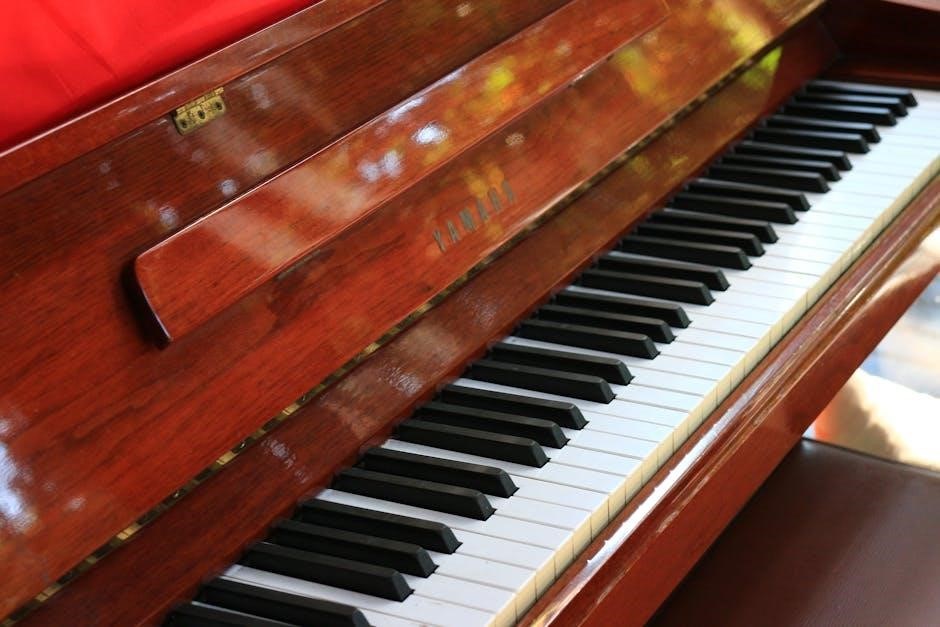The iconic song “Let It Be” by The Beatles is a timeless masterpiece, offering deep emotional resonance and musical complexity. Its piano chords and melody have inspired countless musicians, making it a popular choice for learners and professionals alike. With numerous resources available, including PDF sheet music and tutorials, mastering this piece is more accessible than ever. Explore the significance, structure, and tips for playing “Let It Be” on piano with ease.
Overview of “Let It Be” and Its Significance
“Let It Be” by The Beatles is a timeless ballad written by Paul McCartney, released in 1970. The song’s emotional depth, combined with its iconic melody and chord progressions, has made it a beloved classic worldwide. Its significance lies in its universal message of hope and comfort, resonating with listeners across generations. The song is structured in the key of D major, featuring a simple yet powerful piano arrangement that underscores its memorable chord progressions. Its enduring popularity has led to numerous adaptations and covers, cementing its place in music history. Learning to play “Let It Be” on piano is a rewarding experience, offering both musical growth and emotional connection.
Importance of Piano Chords in the Song
The piano chords in “Let It Be” form the emotional and structural foundation of the song. They provide the harmonic framework that supports the melody and lyrics, creating a sense of balance and depth. The chord progressions are both simple and powerful, allowing the song to resonate emotionally with listeners. By mastering these chords, pianists can capture the essence of the song’s comforting and uplifting message. The chord sequences also enable seamless transitions between verses, choruses, and the bridge, making the song flow naturally. Understanding and playing these chords is essential for any pianist aiming to deliver an authentic and moving performance of “Let It Be.”
Why Learning from a PDF is Beneficial
Learning from a PDF is highly advantageous for mastering “Let It Be” on the piano. PDFs provide a clear, concise, and visually structured format that makes reading sheet music and chords effortless. They are easily accessible and can be downloaded instantly, allowing you to practice anytime and anywhere. PDFs also maintain consistent formatting across devices, ensuring that the sheet music appears the same on your phone, tablet, or computer. Additionally, PDFs are often free or low-cost, making them an affordable resource for musicians. They can be printed or viewed digitally, giving you flexibility in how you learn. This convenience makes PDFs an excellent choice for pianists of all skill levels.

The Song’s Background
Written by Paul McCartney, “Let It Be” was released in 1970 during The Beatles’ internal conflicts. It conveys a message of hope, becoming a timeless classic.
Historical Context of “Let It Be”
“Let It Be,” written by Paul McCartney, was composed in 1968 during a turbulent period for The Beatles. McCartney has said the song was inspired by a dream he had about his mother, Mary, who passed away when he was a teenager. The song’s message of comfort and hope resonated deeply, especially as the band faced internal conflicts and eventual breakup. Released in 1970 on the album Let It Be, it became one of their final singles before the band dissolved. The song’s timeless appeal has made it a beloved classic, often praised for its emotional depth and universal message of solace.
The Beatles’ Influence on Piano Music
The Beatles significantly shaped the role of piano in popular music, with songs like “Let It Be” showcasing its emotional power. Their innovative use of piano chords and melodies elevated the instrument’s prominence in rock and pop. Paul McCartney’s mastery of piano-driven compositions influenced countless artists, blending classical and contemporary styles. The Beatles’ music expanded the piano’s versatility, making it a focal point in many of their tracks. Their work inspired future generations to experiment with chord progressions and harmonic structures, leaving a lasting legacy in piano-based music. Their influence remains evident in modern piano arrangements and performances.
Structure of the Song
“Let It Be” follows a timeless structure that enhances its emotional impact. The song begins with a soothing piano intro, setting a calm tone. It then transitions into the first verse, where simple yet powerful chords accompany the melody. The chorus builds on this foundation, introducing a memorable progression that emphasizes the song’s uplifting message. A bridge adds depth, modulating to a new key before returning to the final chorus. The outro resolves the song gently, reinforcing its reflective nature. This clear, balanced structure makes it accessible for pianists to learn and perform, with chord progressions that align perfectly with the emotional arc of the lyrics.

Piano Chords in “Let It Be”
The piano chords in Let It Be are central to its emotional depth, featuring a mix of major and minor progressions that beautifully support the melody and harmony. PDF resources provide clear arrangements for learning these iconic chords.
Basic Chords Used in the Song
The basic chords used in Let It Be include G, Em, C, D, and Am, which form the harmonic foundation of the song. These chords create a balance of major and minor tones, contributing to the song’s emotional depth. The G chord sets a strong, uplifting tone, while the Em and Am chords add a touch of melancholy. The C and D chords serve as transitional elements, smooth¬ly connecting the verses and choruses. A PDF of the sheet music highlights these chords clearly, making it easier for pianists to learn and play along. Mastering these chords is essential for capturing the song’s essence.
Chord Progressions for Verses
The verses of Let It Be follow a simple yet powerful chord progression that sets the song’s emotional tone. The progression begins with a G chord, moving to G7, then to C, and finally to C7. This sequence creates a gentle, flowing rhythm that supports Paul McCartney’s heartfelt lyrics. The use of seventh chords adds depth and complexity to the melody. A PDF of the sheet music provides clear notation for these progressions, making it easier for pianists to follow. Practicing these transitions smoothly is key to capturing the song’s essence. This progression repeats throughout the verses, establishing a sense of familiarity and continuity.
Chord Progressions for the Chorus
The chorus of Let It Be features a uplifting and iconic chord progression that elevates the song’s emotional impact. It begins with a C major chord, transitioning to a G major, followed by an A minor, and resolving with an F major. This sequence creates a sense of resolution and hope, perfectly complementing the song’s inspiring lyrics. The PDF sheet music highlights these chords clearly, allowing pianists to play with confidence. The progression repeats for each chorus, reinforcing the song’s memorable melody. Mastering these chords is essential for delivering a powerful and moving performance of the chorus.
Bridge Chord Progressions
The bridge of Let It Be introduces a subtle yet powerful chord progression that adds depth to the song. It begins with an A minor chord, followed by an E minor, creating a somber yet reflective mood. The progression then transitions to a G major and finally resolves with a C major, mirroring the song’s main structure. This sequence enhances the emotional buildup before leading back to the final chorus. The PDF sheet music provides clear notation for these chords, ensuring pianists can execute the bridge seamlessly; Practicing these progressions will help musicians capture the song’s dynamic range and emotional intensity.
Outro Chord Progressions
The outro of Let It Be features a simple yet heartfelt chord progression that brings the song to a gentle close. It primarily uses C major, G7, and A minor 7th chords, played softly to create a calming effect. The progression mirrors the verse but with a slower, reflective pace. The PDF sheet music highlights these chords with clear markings, ensuring pianists can play them with the appropriate dynamics. By following the notation, musicians can replicate the song’s soft, emotional conclusion. This section is key to leaving a lasting impression, as the outro’s chord progression resonates deeply with listeners.

Sheet Music and PDF Resources
Find authentic Let It Be sheet music and piano chords PDFs on trusted platforms like official Beatles websites or reputable music stores. Ensure accuracy and clarity for optimal learning.
Where to Find Reliable “Let It Be” Sheet Music
Reliable sheet music for Let It Be can be found on trusted platforms like Musicnotes, Sheet Music Plus, or the official Beatles website. These sources provide accurate piano chords and notation, ensuring authenticity. Additionally, websites like Piano Nanny or Pianu offer high-quality PDFs tailored for pianists. Always opt for licensed versions to support creators and avoid legal issues. Be cautious of unofficial sites, as they may contain errors or incomplete arrangements. For beginners, look for versions labeled “easy piano” or “piano chords only” to simplify learning. These resources ensure you have the correct foundation to master the song effectively.
Features of a Good Piano Chords PDF
A good piano chords PDF for Let It Be should include clear and readable notation, with large enough fonts to avoid eye strain. It should feature accurate chord progressions and timing markings to help pianists sync with the melody. Look for PDFs with finger placement guides or diagrams to aid beginners. Additionally, a numbered system or tablature can simplify learning. The PDF should also include lyrics if applicable, aligned with the chords for easy reference. A key signature guide and tempo markings ensure proper interpretation. Finally, a table of contents or bookmarks enhances navigation, making it easier to jump to specific sections.
How to Download and Print the Sheet Music
To download and print the sheet music for “Let It Be,” start by visiting a trusted website like Musicnotes or Piano Nanny. Search for “Let It Be” and select the piano version; If required, create an account or log in. Purchase or access the PDF, then download it to your device. Locate the file in your downloads folder and open it using a PDF reader. Adjust print settings for proper scaling and paper size. Use high-quality paper for clarity. Ensure your printer has sufficient ink and is aligned. Print a test page if needed. Once satisfied, print the sheet music and organize it for practice.

Learning to Play “Let It Be” on Piano
Learning to play “Let It Be” begins with mastering basic chords and transitions, then adds emotional depth through dynamics and tempo control. Continuous practice ensures a polished performance.
Step-by-Step Guide for Beginners
Start by learning the basic chords from the PDF, such as C, G, Am, F, and D7. Practice switching between chords slowly to build finger strength and accuracy. Begin with the verse structure, focusing on smooth transitions between C and G. Once comfortable, incorporate the chorus, emphasizing the emotional lift of the F chord. Pay attention to dynamics and tempo, gradually increasing speed as confidence grows. Use a metronome to maintain rhythm and practice hands separately before combining them. Finally, add emotional expression by varying touch and pace, ensuring a heartfelt performance that captures the song’s essence.
Practicing Chord Transitions Smoothly
To master chord transitions in “Let It Be,” focus on breaking down the verses into smaller sections. Practice switching between chords like C and G slowly, ensuring clean finger placement. Use a metronome to maintain a steady rhythm, starting at a slower tempo and gradually increasing. Pay attention to finger independence and minimize hand movement. Isolate challenging transitions, such as moving from Am to F, and practice these repeatedly. Incorporate dynamics by playing softly during verses and increasing volume in the chorus. Finally, add emotional depth by varying your touch and timing, making the transitions feel natural and expressive.
Adding Emotional Depth to Your Performance
To add emotional depth to your “Let It Be” performance, focus on dynamics and phrasing. Play verses softly with gentle, flowing arpeggios, then build intensity in the chorus with stronger chords. Use rubato to slightly slow or speed up emotional peaks, like the “whisper words of wisdom” line. Emphasize key lyrics by lingering on chords or adding subtle crescendos. Experiment with sustain pedal to create a reverberant, ethereal sound; Connect with the song’s message of hope and comfort, allowing your feelings to guide your playing. This will make your performance resonate deeply with listeners, capturing the song’s timeless emotional essence.

Additional Resources and Tools
Explore online tutorials, piano learning apps, and forums for “Let It Be” sheet music. Utilize tools like Fender Play, Piano Maestro, and Reddit’s piano community for support.
Online Tutorials for “Let It Be” Piano
Online tutorials offer step-by-step guidance for mastering “Let It Be” on piano. Platforms like YouTube and Piano Nanny provide detailed video lessons, breaking down chord progressions and melodies. Websites such as HDpiano and Piano Lessons Online offer interactive tutorials, focusing on rhythm and timing. Apps like Skoove and Flowkey also feature “Let It Be” lessons, combining video instruction with interactive exercises. These resources cater to all skill levels, ensuring learners can progress smoothly. They often include PDF downloads for chord charts and sheet music, making practice convenient. Utilizing these tools enhances your learning experience, helping you play confidently and expressively.
Piano Learning Apps and Software
Piano learning apps and software are excellent tools for mastering “Let It Be.” Apps like Fender Play and Yousician offer interactive lessons tailored to your skill level. Skoove provides video tutorials and exercises specifically for learning popular songs. Synthesia is another great option, using falling notes to help you learn visually. These platforms often include chord charts and sheet music for “Let It Be,” making practice seamless. They also offer progress tracking and personalized feedback. Whether you’re a beginner or an intermediate player, these tools enhance your learning experience. They are accessible on both mobile and desktop, allowing you to practice anywhere. These apps are indispensable for improving your piano skills effectively.
Communities and Forums for Support
Joining piano communities and forums can enhance your learning journey with “Let It Be.” Platforms like Reddit’s r/piano and r/WeAreTheMusicMakers offer valuable discussions and tips. Facebook groups dedicated to piano learners are also great for connecting with others. Specialized forums such as Piano World and Piano Forums provide in-depth advice and resources. These communities allow you to share your progress, seek feedback, and learn from others. They often discuss challenges in songs like “Let It Be” and offer solutions. Engaging with these groups can motivate you to practice consistently and refine your skills. Active participation fosters growth and camaraderie among musicians.

Advanced Techniques
Mastering advanced techniques enhances your “Let It Be” performance. Try improvising over chord progressions, experimenting with arpeggios, and incorporating dynamic finger placement for a polished sound.
Improvising Over the Chord Progressions
Improvising over “Let It Be” chord progressions allows pianists to add personal flair. Start by mastering the D Major scale, as the song is written in this key. Experiment with arpeggios or melodic patterns over the verse and chorus chords. For example, during the C-G-Am-F progression, try playing broken chords or subtle runs. Pay attention to emotional expression, as the song’s essence lies in its feeling. Begin with simple embellishments and gradually incorporate more complex ideas. Remember, improvisation is about connection, so let the music guide your creativity. Practice regularly to refine your technique and make the piece uniquely yours.
Using Pedals for Enhanced Sound
Using pedals can enhance the emotional depth of “Let It Be.” The sustain pedal adds resonance by holding notes longer, creating a fuller sound. Apply it during verses to let chords ring out smoothly. For the chorus, use the sostenuto pedal to sustain specific bass notes while playing melodies. The soft pedal reduces volume, ideal for quieter moments, like the song’s intro. Experiment with pedal timing to avoid muddying the sound. Subtle pedal use can elevate the song’s atmosphere, making it more expressive and professional. Practice pedal control to achieve the desired effect without overpowering the melody.
Advanced Finger Placement Tips
Optimal finger placement is crucial for mastering Let It Be. Use fingers 1 and 5 for outer notes to maintain chord shapes. For smooth transitions, keep fingers close to keys and shift minimally. Practice finger independence exercises to improve dexterity. In the chorus, use a rotational wrist motion for arpeggios. For complex chords, prioritize the melody notes with your strongest fingers. Experiment with finger substitution to reduce strain. Focus on legato playing by gliding between notes where possible. Regular practice will enhance accuracy and control, ensuring a polished performance. These techniques refine your playing, making the song sound professional and emotionally resonant.

Key and Scale
Let It Be is written in the key of D major, with a scale consisting of D, E, F#, G, A, B, and C#. This key choice provides a bright, uplifting feel, while its scale degrees form the foundation for the song’s chord progressions and melody, creating emotional depth and resonance.
Understanding the Key of D Major
The key of D major is central to the composition of Let It Be. This key is defined by a scale consisting of the notes D, E, F#, G, A, B, and C#. The D major key signature includes two sharps—F# and C#—which influence the chord progressions and melody. The choice of D major contributes to the song’s uplifting yet reflective feel, balancing brightness with emotional depth. This key also aligns with the natural range of the piano, making it accessible for pianists to play. Understanding the D major key is essential for accurately interpreting the sheet music and performing the song with authenticity and emotional resonance.
Scale Degrees and Chord Relationships
In the key of D major, the scale degrees form the foundation for chord relationships in Let It Be; The tonic (D) establishes stability, while the subdominant (G) and dominant (A) create movement. The song’s verses rely on chords built from these scale degrees, such as D, G, and A. The chorus introduces the vi (B minor) and vii° (F# minor) chords, adding emotional depth. These relationships define the harmonic structure, guiding the melody and chord progressions. Understanding how scale degrees translate into chords is crucial for interpreting the sheet music accurately and capturing the song’s essence. This harmony is central to the song’s timeless appeal and emotional resonance.

Transposition and Variations
Transposing “Let It Be” allows players to adapt the song to different keys, offering fresh perspectives. Variations can enhance creativity, enabling unique interpretations while maintaining the original melody’s essence.
How to Transpose the Song to Different Keys
To transpose “Let It Be” to different keys, start by identifying the original key, typically C Major. Use the circle of fifths to determine the new key’s chord relationships. Adjust each chord accordingly, such as moving C to G and G to D when transposing up a fourth. Maintain the melody’s interval structure, ensuring it remains within a playable range. Utilize music theory knowledge to understand scale and chord constructions. Practice the transposed version gradually, starting with the original tempo. Consider using tools or software to aid in accurate transposition. This process enhances creativity and adaptability, allowing the song to fit various vocal ranges or moods.
Creating Your Own Variations
Creating your own variations of “Let It Be” allows you to infuse personal creativity while maintaining the song’s essence. Start by experimenting with tempo or dynamics to alter the feel. Consider adding embellishments like arpeggios or melodic fills to enhance the melody. Incorporate different musical styles, such as jazz or classical, by modifying chord voicings or rhythm. Utilize music software or apps to compose and record your variations. Encourage yourself to explore and innovate, making the song uniquely yours. Share your interpretations with others to inspire and learn from their creative approaches.

Frequently Asked Questions
Common questions about “Let It Be” piano chords include difficulty levels, required prior experience, and where to find accurate PDF resources. Addressing these helps learners master the song effectively and encourages creative practice.
Common Mistakes When Playing “Let It Be”
When learning “Let It Be” from a PDF, common mistakes include rushing the tempo, playing chords too forcefully, and incorrect chord voicings. Many pianists also struggle with smooth chord transitions and dynamics. Neglecting finger placement can lead to misplayed notes, while inconsistent tempo disrupts the song’s emotional flow. Some players overlook the importance of pauses between sections, causing the piece to feel rushed. Additionally, improper use of pedals and ignoring scale relationships can alter the song’s intended sound. Addressing these issues ensures a more authentic and heartfelt performance, aligning with the original composition’s intent.
Troubleshooting Chord Voicings
Troubleshooting chord voicings in “Let It Be” involves addressing common issues like muddied tones or inaccurate harmonies. Simplify chords by omitting non-essential notes to enhance clarity. Ensure voicings align with the song’s emotional texture, opting for softer dynamics when needed. Consistent chord inversions are crucial; stick to root positions or specified inversions from the PDF. Avoid overusing the sustain pedal, as it can blur chord definitions. Proper hand positioning and finger placement are essential for precise voicings. By refining these aspects, you can achieve a cleaner, more expressive sound that captures the essence of the song.
Final Tips for Mastering the Song
Mastering “Let It Be” requires consistent practice and patience. Break the song into sections and focus on chord transitions to ensure smoothness. Pay attention to emotional expression, as it elevates the performance. Use a metronome to improve timing accuracy; Regularly review the PDF sheet music to avoid mistakes. Incorporate dynamics like crescendos and diminuendos for depth. Record yourself to identify areas for improvement. Experiment with pedal techniques to enhance sound quality. Join online communities or forums for feedback and motivation. Remember, persistence is key—mastering this iconic piece will be deeply rewarding.
Encouragement for Continuous Practice
Continuous practice is vital for mastering “Let It Be.” Each session enhances your technique and emotional expression. Celebrate small milestones to stay motivated. The journey is as rewarding as the performance, fostering a deeper connection to the music. Set achievable goals and remain persistent. The satisfaction of playing this beloved song makes every practice worthwhile. Enjoy the process, and relish the joy of bringing this timeless melody to life. Remember, persistence leads to mastery and the fulfillment of sharing beautiful music.